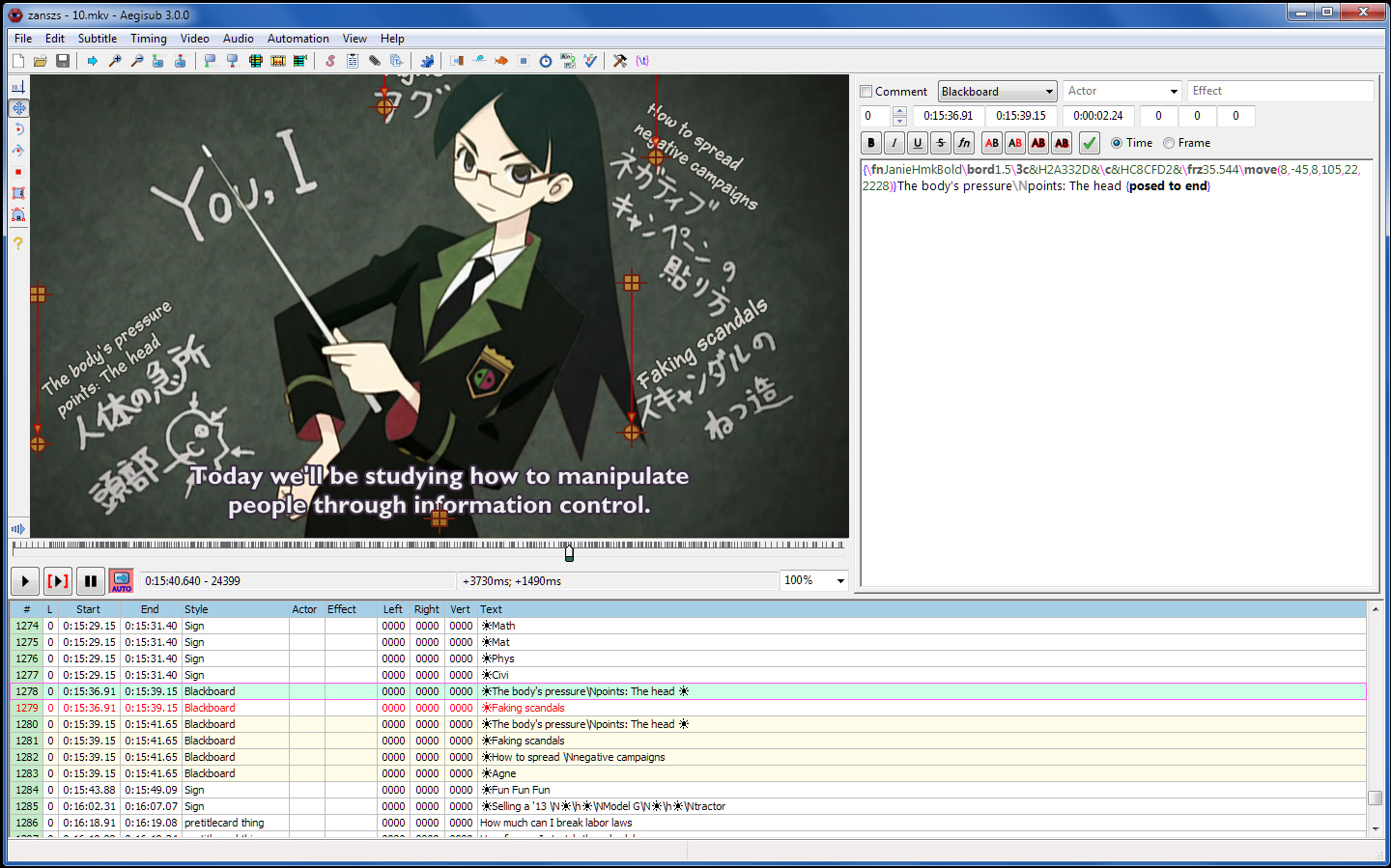
If it didn't work and it's your first try, restart Aegisub and see if it works after that.

Click on "Motion Data - Trim" in the automation menu, and it'll just encode without needing any further action. This is the kind of sign that's easier to track from last frame, and it's better to create it on the last frame too. This is what it looks like on the first frame.and this is the last frame. Let's look at a sign that needs tracking. This allows you to use different tracking data for clip than for the sign itself. Linear - this will use \move and \t instead of frame-by-frame tracking.ĭelete - Delete the source lines instead of commenting them out.Īutocopy - Automatically copy from clipboard into the tracking data box.Ĭopy Filter - Only autocopy if the clipboard appears to contain tracking data. Or you can style the sign on frame 6 and set this to 6, etc. If it's hard to position the sign on the first frame, you can do so on the last frame and set this to -1. X264 - I never thought of changing this, so. Rounding - how many decimals you'll have for each tracked value. \fscx and \fscy.īorder/Shadow - apply scaling to border / shadow.

X, y - track \pos horizontally/vertically. Sort method: Time - Resulting lines will be sorted by time. Sort method: Default - If you apply data to 2 lines, you'll get line 1 tracked first and line 2 tracked after it. Let's mention what all the options do now, but you can get back to this later. I recommend to uncheck the scaling and border/shadow for default settings. If you chose "D:\mocha\" as your folder, you'll put that in the top part (don't forget the trailing slash),Īnd the same with x264.exe in the middle box, like you see here. Open Aegisub and go to the Automation menu. To make it simple, use the same folder for both. Now you need a folder where the clips for mocha will go, and a folder where your x264.exe will be. x264 8bit-depth (Mocha can't read 10-bit) Place it in \Aegisub\automation\autoload\.Ĥ. Quicktime or Quicktime Lite (Otherwise Mocha won't load mp4)ģ.

I will try to do it through Aegisub as you suggested.2015 Note: Even though I've updated this a number of times, stuff keeps evolving and changing.Ĭheck this site for torque's updated guide to his Motion script.ġ. Here are two pictures: Unfortunately that old version of Avidemux crashes all the time for some reason so it's not usable. The filter which contains the slider is called ''Subtitler''. Thanks a lot, you've been very helpful! FYI I downloaded an older version of Avidemux which has the feature I was talking about.
AEGISUB LONGEST LINE CODE
I've checked the code of Avidemux 2.5.6: at least in that version, there were no styling / positioning controls beyond those present in current 2.7.9 builds. Quote from: eumagga0x2a on September 12, 2021, 07:13:37 PM Quote from: eumagga0x2a on September 10, 2021, 10:13:22 PMThere might have been some rudimentary styling / positioning controls in Avidemux 2.5.x removed during the rewrite of the application which led to Avidemux 2.6.x. I've got finally a chance to check what this option really does (it adds margins to the output picture, changing the aspect ratio, and enables libass to render subtitles into those margins).

Quote from: eumagga0x2a on September 12, 2021, 07:06:42 PM Quote from: Andrew546 on September 10, 2021, 09:36:30 PMIncreasing the bottom margin doesn't appear to move the subs from what i can see, and even if it did this isn't a great solution since I don't want larger margins on the video than I already have. Of course, you can use Aegisub to perform these changes graphically without danger of messing up the syntax. Increase this value if you want the subtitles to be rendered higher. In this example, "Default" in the second line is the name of the style and penultimate field with value "10" (in units of resolution, usually in pixel, when the values of PlayResX and PlayResY match the pixel size of the picture) is the vertical margin relative to the bottom border of the picture. Format: Name, Fontname, Fontsize, Primar圜olour, Secondar圜olour, OutlineColour, BackColour, Bold, Italic, Underline, StrikeOut, ScaleX, ScaleY, Spacing, Angle, BorderStyle, Outline, Shadow, Alignment, MarginL, MarginR, MarginV, Encoding


 0 kommentar(er)
0 kommentar(er)
